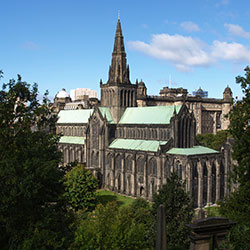Measuring the Impact of Climate Change on Historic Buildings
 Climate Change – A Major Concern for Historic Buildings
Climate Change – A Major Concern for Historic Buildings
In Scotland’s wet climate, rainfall can have a critical impact on the rate of sandstone decay in historic buildings. With climate change, predicted increases in winter rainfall may, in addition to stone saturation, accelerate the decay process by affecting the growth and loss of biological and pollutant crusts on building stonework. This leads to sandstone discolouration, spalling (i.e., flaking), and exposure of the underlying face, with further weakening to the structural integrity. Knowledge of the potential effects of climate change is vital to Historic Scotland, which is responsible for safeguarding the nation’s built heritage. Understanding how sandstone decay may be impacted by higher rainfalls will be a key factor in developing strategies to limit damage to historic buildings and inform Historic Scotland’s maintenance plan for properties in its care.
Biological and Biomineralic Crusts Pose a Difficult Challenge
Biological and biomineralic crusts are difficult to characterise by conventional laboratory techniques, and so their composition and structure are poorly understood. Some will aggressively attack sandstone through the action of organic acids or by grain plucking; others can actually protect the underlying stone by binding the top surface and reducing weathering effects. Abrasive cleaning or the application of biocides can be used to remove biological materials, but this may not always be the best means for reducing longer term decay.
Because of its expertise in this field, Glasgow University’s School of Geographical and Earth Sciences (GES) is being funded to assess the impact of different stone compositions and mineralogies on the development of biological crusts on sandstone and to determine whether increased rainfall due to climate change is likely to accelerate sandstone decay. Analytical support is being provided for the project by the Geoanalytical Electron Microscopy and Spectroscopy centre (GEMS) in GES.
By using Raman spectroscopy with scanning electron microscopy (SEM), both of which are non-destructive techniques available in ISAAC, the mineralogy of sandstones and their cements can be characterised. Over time, biological activity may be measured and compared for a range of samples under varied environmental conditions.
Download the Measuing the Impact of Climate Change on Historic Buildings case study.

